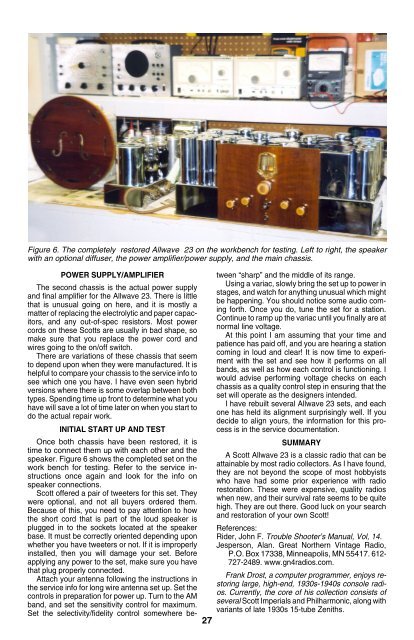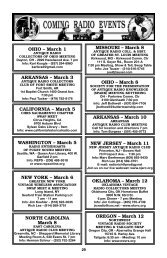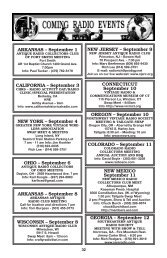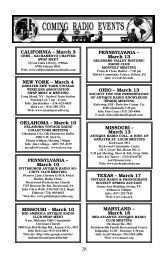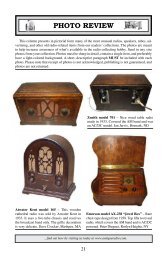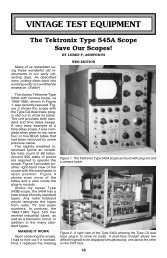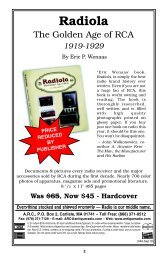Rebuilding a Scott Allwave 23 - Antique Radio Classified
Rebuilding a Scott Allwave 23 - Antique Radio Classified
Rebuilding a Scott Allwave 23 - Antique Radio Classified
You also want an ePaper? Increase the reach of your titles
YUMPU automatically turns print PDFs into web optimized ePapers that Google loves.
Figure 6. The completely restored <strong>Allwave</strong> <strong>23</strong> on the workbench for testing. Left to right, the speaker<br />
with an optional diffuser, the power amplifier/power supply, and the main chassis.<br />
POWER SUPPLY/AMPLIFIER<br />
The second chassis is the actual power supply<br />
and final amplifier for the <strong>Allwave</strong> <strong>23</strong>. There is little<br />
that is unusual going on here, and it is mostly a<br />
matter of replacing the electrolytic and paper capacitors,<br />
and any out-of-spec resistors. Most power<br />
cords on these <strong>Scott</strong>s are usually in bad shape, so<br />
make sure that you replace the power cord and<br />
wires going to the on/off switch.<br />
There are variations of these chassis that seem<br />
to depend upon when they were manufactured. It is<br />
helpful to compare your chassis to the service info to<br />
see which one you have. I have even seen hybrid<br />
versions where there is some overlap between both<br />
types. Spending time up front to determine what you<br />
have will save a lot of time later on when you start to<br />
do the actual repair work.<br />
INITIAL START UP AND TEST<br />
Once both chassis have been restored, it is<br />
time to connect them up with each other and the<br />
speaker. Figure 6 shows the completed set on the<br />
work bench for testing. Refer to the service instructions<br />
once again and look for the info on<br />
speaker connections.<br />
<strong>Scott</strong> offered a pair of tweeters for this set. They<br />
were optional, and not all buyers ordered them.<br />
Because of this, you need to pay attention to how<br />
the short cord that is part of the loud speaker is<br />
plugged in to the sockets located at the speaker<br />
base. It must be correctly oriented depending upon<br />
whether you have tweeters or not. If it is improperly<br />
installed, then you will damage your set. Before<br />
applying any power to the set, make sure you have<br />
that plug properly connected.<br />
Attach your antenna following the instructions in<br />
the service info for long wire antenna set up. Set the<br />
controls in preparation for power up. Turn to the AM<br />
band, and set the sensitivity control for maximum.<br />
Set the selectivity/fidelity control somewhere be-<br />
27<br />
tween “sharp” and the middle of its range.<br />
Using a variac, slowly bring the set up to power in<br />
stages, and watch for anything unusual which might<br />
be happening. You should notice some audio coming<br />
forth. Once you do, tune the set for a station.<br />
Continue to ramp up the variac until you finally are at<br />
normal line voltage.<br />
At this point I am assuming that your time and<br />
patience has paid off, and you are hearing a station<br />
coming in loud and clear! It is now time to experiment<br />
with the set and see how it performs on all<br />
bands, as well as how each control is functioning. I<br />
would advise performing voltage checks on each<br />
chassis as a quality control step in ensuring that the<br />
set will operate as the designers intended.<br />
I have rebuilt several <strong>Allwave</strong> <strong>23</strong> sets, and each<br />
one has held its alignment surprisingly well. If you<br />
decide to align yours, the information for this process<br />
is in the service documentation.<br />
SUMMARY<br />
A <strong>Scott</strong> <strong>Allwave</strong> <strong>23</strong> is a classic radio that can be<br />
attainable by most radio collectors. As I have found,<br />
they are not beyond the scope of most hobbyists<br />
who have had some prior experience with radio<br />
restoration. These were expensive, quality radios<br />
when new, and their survival rate seems to be quite<br />
high. They are out there. Good luck on your search<br />
and restoration of your own <strong>Scott</strong>!<br />
References:<br />
Rider, John F. Trouble Shooter’s Manual, Vol, 14.<br />
Jesperson, Alan. Great Northern Vintage <strong>Radio</strong>,<br />
P.O. Box 17338, Minneapolis, MN 55417. 612-<br />
727-2489. www.gn4radios.com.<br />
Frank Drost, a computer programmer, enjoys restoring<br />
large, high-end, 1930s-1940s console radios.<br />
Currently, the core of his collection consists of<br />
several <strong>Scott</strong> Imperials and Philharmonic, along with<br />
variants of late 1930s 15-tube Zeniths.


